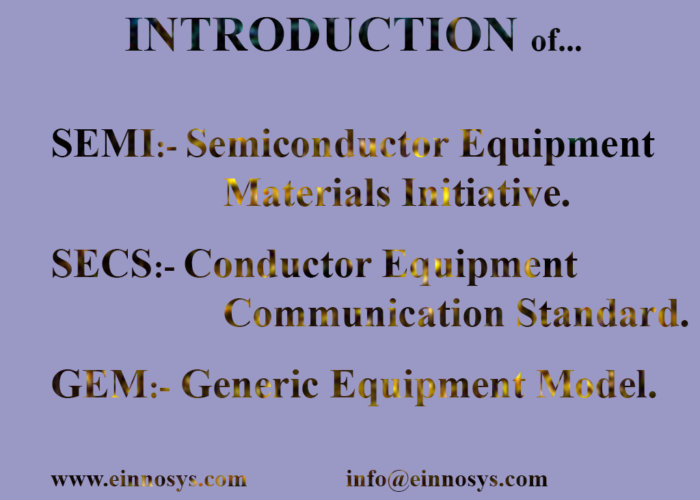In the world of semiconductor manufacturing, communication between equipment and factory systems is critical for efficiency, automation, and cost control. To make this communication seamless, the industry relies on well-defined standards known as SEMI, SECS, and GEM. Let’s take a closer look at what these terms mean and why they matter.

What Do SEMI, SECS, and GEM Stand For?
SEMI – Semiconductor Equipment and Materials International, an organization that develops global standards for semiconductor and electronics industries.
SECS – Semiconductor Equipment Communication Standard, which defines how semiconductor equipment communicates with host systems.
GEM – Generic Equipment Model, a set of guidelines for communications and control of manufacturing equipment.
Together, SECS/GEM standards ensure a common “language” for equipment-to-host communication in fabs and assembly facilities.
Why Were SECS/GEM Standards Introduced?
The semiconductor industry began adopting automation standards in the 1970s. At that time, communication between equipment and factory hosts was often proprietary, inconsistent, and expensive to implement.
Without a standard, every equipment manufacturer had to design unique communication protocols for each fab, leading to:
High development and integration costs
Performance issues
Longer equipment setup times
SEMI addressed this by introducing SECS/GEM standards—a unified way for equipment and hosts to exchange information. Much like how TCP/IP standardizes network communication or RS232 standardizes serial communication, SECS/GEM created a universal framework for semiconductor automation.
How Do SECS/GEM Standards Work?
The SECS/GEM standard must be implemented on both sides of the communication:
On the Equipment Side – The equipment’s computer runs SECS/GEM software that complies with SEMI standards such as E30, E4, E5, and E37. This software manages message formats, event reporting, and remote commands.
On the Host Side – The factory host software also implements the same SEMI standards. This ensures that the host can send commands, receive data, and control the equipment reliably.
By ensuring both sides “speak the same language,” fabs and equipment manufacturers achieve seamless interoperability.
Benefits of SECS/GEM Standards
Implementing SECS/GEM provides significant advantages to both fabs and OEMs:
Interoperability – Equipment from different vendors can easily integrate with fab automation systems.
Reduced Costs – No need for custom protocols or one-off integrations.
Faster Deployment – Standardized communication shortens installation and validation time.
Improved Efficiency – Consistent data collection, event reporting, and control functions enhance overall manufacturing productivity.
Scalability – As fabs adopt more automation, SECS/GEM ensures that new equipment fits into the existing ecosystem.
Why SECS/GEM Matters Today
Even decades after its introduction, SECS/GEM remains the foundation of smart manufacturing in semiconductors. Modern fabs are highly automated, with thousands of tools connected to centralized host systems. Without a standard protocol, this level of integration would be impossible.
As factories adopt AI, predictive maintenance, and advanced analytics, reliable and standardized data from equipment becomes even more important. SECS/GEM ensures that this data flows consistently, enabling fabs to optimize yield, reduce downtime, and stay competitive.
Conclusion
The SEMI SECS/GEM standards transformed semiconductor manufacturing by creating a universal framework for equipment and host communication. By eliminating proprietary protocols, these standards reduced costs, improved efficiency, and paved the way for today’s advanced automation.
For fabs and OEMs, adopting SECS/GEM isn’t just about compliance—it’s about ensuring smooth integration, scalability, and long-term success in a rapidly evolving industry.
To learn more about SECS/GEM integration solutions, explore Einnosys SECS/GEM products and services

